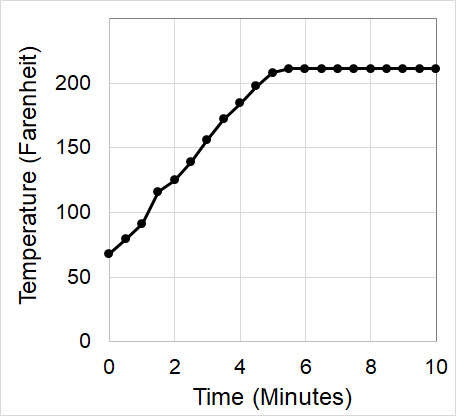Purpose: Over 25 years ago, in ScientificAmeriKen's
6th experiment, an experiment was performed to test whether water
starting hot
or cold would boil first.Since that time, technology has improved
and a further realization developed - that there are many experiments
still to do with water! Of particular interests is the addition
of salt to boiling water, which supposedly makes cooking pasta
easier. Here, ScientificAmeriKen explores whether sugar can substitute
in altering the properites of boiling water. If successful, pasta
cooking will clearly be revolutionized!
 |
| Figure 1. ScientificAmeriKen Boils water c.1996 |
Hypothesis: Both salt and sugar appear to dissolve
readily into water, therefore it is the hypothesis of this experiment
that both will increase the temperature that water boils at.
Methodology: Used in this experiment is a small
pot, water from tap, gas range, meat thermometer (pictured below),
whisk, measuring cup, cell phone stop watch, pen and paper. Water
(2 cups) was added to the pot with the gas range set at "high".
Measurements with the thermometer were taken every 30 seconds
for a total of 10 minutes. Next, 2 cups of water was brought to
a boil. 0.5 teaspoons of salt was added in succession and temperature
taken after stirring with the whisk. This was repeated a total
of 10 times for a total of 5 teaspoons of salt. The procedure
was repeated for sugar.
Results: Initially, the two cups
of water took approximately 5 minutes to come to a boil. Temperature
at boil was 211.1 oF (Figure 2). Altitude of Buffalo,
NY is approximately 500 ft which may explain why a boiling temperature
of 212 oF was not reached. Over the ten minute boiling
time a total of 0.25 cups of water evaporated (water poured back
into measuring cup after 10 minutes). Next, salt or sugar was
added to boiling water (Figure 3). The data show salt increased
the temperature of the water approximately 0.3-0.4 oF
per half-teaspoon, whereas sugar increased the temperature by
about 0.2-0.3 oF after the entire 5 teaspoons. Interestingly,
0.5 cups of water evaporated with the salt wherease 0.25 cups
evaporated with the sugar.
 |
Figure 2. Time to reach
boiling. Cold water was taken from tap
(2 cups) and heated on "high". Temperature was measured
every 30 seconds. |
|
 |
Figure 3. Boiling temperatures
of when adding salt versus sugar. Water was brought
to a boil and then salt or sugar was added 1 teaspoon at a
time. |
Conclusion: This experiment proves there are always
things to do with the world's coolest substance - water! The original
experiment 25 years ago proved that the hotter water starts boiling
faster than the colder water. With the meat thermometer this issue
is not even in question - under the conditions of this experiment
the water heated up consistently about 12-13 degrees per 30 seconds.
Thus, it one would summise colder water would take that much longer
to reach boiling. The next phase of the experiment yielded the surprise
that simply adding any substance that dissolves in water does not
guarantee it will significantly affect the boiling temperature.
Salt clearly was the winner. However, the effect of salt was not
as dramatic as expected. 5 teaspoons of salt in 2 cups only increased
the temperature about 4 degrees - supposedly thats all it takes
to make the perfect pot of pasta! Finally, although sugar failed
to impress, this experimental design opens up exploration into other
potential mixtures that affect how water boils, and ultimately,
generate food ideas.



